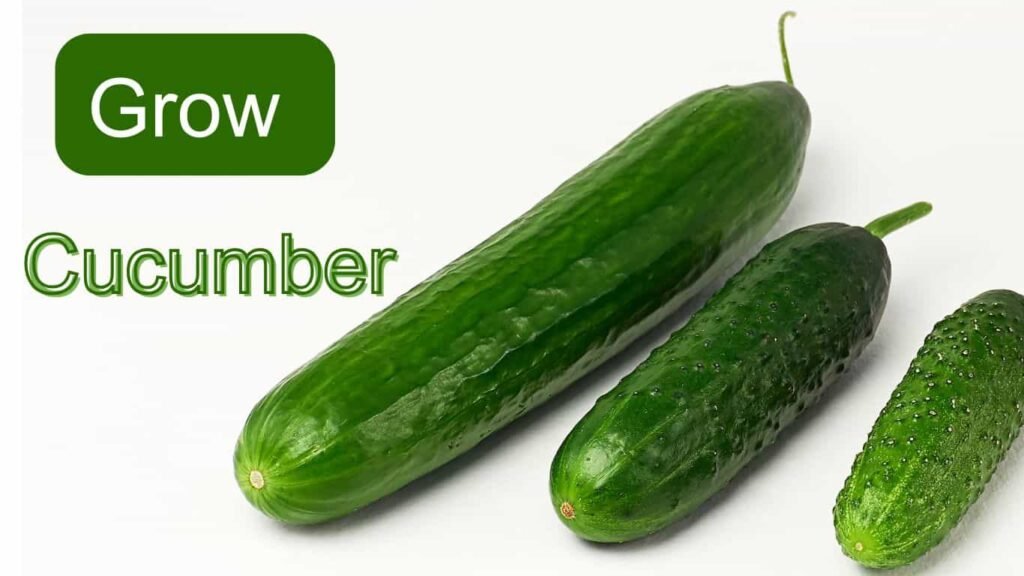I grow tomatoes at my home on my balcony using containers or pots. On the other hand, my grandfather grows tomatoes on the ground. And we both grow different types of tomatoes. But how are we able to successfully grow and harvest them? How can you grow as a beginner or even an experienced gardener? Well, that’s what we will discuss throughout this article.
Growing tomatoes at home is really easy and satisfying. You just have to remember some important things, such as suitable pot size (if you want to grow in a container). High-quality soil, water, light, fertilizer, care, etc. And then you can grow. However, let’s understand it step by step.
Choose the right tomato varieties

Well, there are different types of varieties of tomatoes that you can consider growing at home or in the garden. But before that, let’s understand about determinate and indeterminate tomatoes.
Determinate vs Indeterminate Tomatoes
Determinate tomatoes are compact, bush-like plants that produce fruit in a short period of time. It’s a good choice if you want to grow tomatoes in pots or you have a small garden because they don’t even need too much vertical space.
On the other hand, indeterminate tomatoes are like vining plants. So they can continue to grow and produce fruit throughout the season. (Yeah! Tomatoes are fruits), not a vegetable.
Besides this, indeterminate tomatoes also become large in size. And they need more staking support. That’s why they also offer a longer and more continuous harvest. Now, let’s talk about variety.
Popular Tomatoes variety is for Gardener and Containers
There are basically three best varieties that I suggest you grow: Cherry, Beef Steak, and Heirloom.
1. Cherry Tomatoes (for Containers)
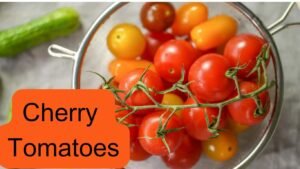
If you are a small gardener and you have a small space or want to grow at home in containers, I would suggest you look for cherry tomato varieties.
They are small in size and the popular one. However, in cherry varieties, you can look for Sweet 100, Sun Gold, or Chocolate Cherry. They will give you a bountiful harvest of bite-size. Trust me, they are really flavorful. And they also look cute because I have cherry tomatoes, too.
2. Beefsteak for gardeners

If you have a large garden, then you can consider going with Beefsteak Tomatoes. You can choose Brandywine, Mortgage Lifter, or Cherokee Purple from this variety. They are pretty good. You would love them because they are big, juicy slicers. And they taste like homegrown, too.
Many times, you will also find them in supermarkets because farmers grow them in large gardens to sell in markets.
3. Heirloom Tomatoes (Flavor focused)
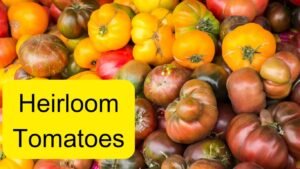
If you are focusing on tomato flavor, I would suggest you try to grow a Heirloom tomato variety. They are very open-pollinated, non-hybrid plants. And they can give you incredibly flavorful tomatoes. But yes, they will be uniformly in size.
During the summer season, you can grow cherry tomatoes in a container or pot. Besides this, if you are a gardener, you can also try beefsteak or heirloom varieties. They will give you a premium homegrown tomato experience.
How to grow tomatoes from seed?
Well, if you want to grow tomatoes from seed, there are a couple of decisions that you have to make first.
Heirloom vs hybrid seeds
As we have also discussed before, heirlooms are open-pollinated, which means they can be saved and replanted year after year. But they will result in exceptional flavors.
On the other hand, hybrids are bred for specific traits like disease resistance or uniform size. But there is no guarantee that the seed will grow like the parent plant.
However, you can still give it a try!
Organic Seeds
I always prefer organic seeds for beginners. Even experienced gardeners can have non-GMO tomato seeds. They will ensure your plant will be free of synthetic chemicals and pesticides. You are probably also growing tomatoes because you want to eat organic and pesticide-free food.
Therefore, I recommend you choose non-GMO for a healthier and more sustainable crop. There are a couple of benefits to starting with quality organic tomato seeds. Such as:
- You will have the control of the growing process from the beginning.
- Being organic seeds, they are more likely to produce flavorful and nutrient-dense fruits.
- Most importantly, you can save seeds from your best-performing plant. And then you can grow it again next year.
You can also try heirloom or hybrid seeds, but my choice would be Organic, non-GMO tomato seeds. On the other hand, if flavor is the priority, then I would choose Heirloom tomatoes as the best because of their flavor. They are a little sweet and fruity.
Besides this. Heirloom tomatoes are different in size and color. Some of them are like deep purples, even vibrant red, etc. And just like non-GMO tomatoes, you can also grow Heirloom tomatoes from the seed year after year.
Now it’s your choice whether you choose flavor and diversity first or organic non-GMO Seed first.
Grow tomatoes from seed step by step
Growing tomatoes from seed is very easy. Here is a step-by-step guide on how you can grow indoors at home. First of all, I assume that you have chosen a tomato seed variety, as we discussed above.
- Timing: It is very important to grow tomatoes from seeds indoors. You have to sow seed indoors around 6-8 weeks before your last expected frost date. This will give seedlings enough time to grow strong before you transplant them into a new container.
- Seed trays and starting mix: Now, you will need a seed tray or a clean container that has a drainage hole. After that, you have to fill them with a high-quality soil mix. This will ensure that your seed has the right nutrients and moisture retention.
- Sow the tomato seeds: Now you can plant the tomato seed about 1/4 or 1/2 inch deeper. However, make sure to keep their space in between them if you are planting multiple seeds.
- Lighting: Now, tomato seedlings need a lot of bright and direct sunlight for at least 6 hours per day. You can also keep the pot or seed near a sunny window. Or you can invest in growing lights.
Now, if you want to maintain humidity and temperature between 70 and 85 Fahrenheit, you can also use a heat map. However, for humidity, you can keep the humidity high by misting the seedlings, or you can also use a covering tray with a plastic dome.
Don’t forget to harden off seedlings
Many people make this mistake when they grow seedlings indoors and then directly plant them outdoors in direct sunlight, which isn’t good for tomato plants.
However, before transplanting your tomato seedlings outdoors, you gradually have to “Harden Them Off.”
But how?
You have to keep your seedlings in a shaded area for a few hours every day for the next 7 to 10 days.
After that, you can increase their sun exposure. You can place them in direct sunlight and wind.
But you should not directly put them in direct sunlight. It is better if you give them some time to adapt to the wind, temperature, fluctuation, etc., although people (especially large space gardeners) mostly grow directly in sunlight.
But here is a thing to remember: large gardeners have grown seedlings in direct sunlight since the beginning. But if you are growing seeds indoors and then transplanting them outdoors, here is the difference: you need to follow the hardening of seedling process.
How to prepare soil to grow tomatoes
Now, whether you grow tomatoes on the balcony, in the backyard, indoors, outdoors, in a large garden, or in a small garden, soil is always necessary, and it needs to produce healthy tomatoes. Therefore, you can consider having well-draining soil with slightly acidic pH. It can be ideally between 6.0-6.8.
If you are growing tomatoes directly into the ground, I would suggest you first test your existing soil. You can either buy an inexpensive soil test kit or you can also visit a local extension office.
They will tell you the current pH and nutrient level. If needed, then you can amend the soil.
You can use organic compost or aged manure to enrich your current soil. By doing so, you can add nutrients and improve drainage.
If you don’t want to visit an extension office or have a soil test kit, then you can directly do soil amendment. So, even if the soil is not nutritious, it will become nutritious.
Most of the time, I’ve seen many people never go for soil testing. They just directly try to grow the plant. If they do not see a result, then they will consider soil amendment without soil testing.
Soil for growing tomatoes in a pot or container
As a container gardener, you will want to use high-quality potting mix, especially ones formulated for vegetables.
Although a good DIY recipe tends to blend equal parts compost, peat moss or coconut coir, and vermiculite or perlite, you can use them as they will provide a perfect balance of nutrients, moisture retention, and aeration.
Remember that proper drainage is very important when you are growing tomatoes. So, you want to make sure there are drainage holes in the bottom of your pot or container to prevent waterlogging.
Growing tomatoes in a pot vs garden
Well! Now you know how to grow tomatoes from seed or seedlings. Now it’s time to remember important things when growing directly into the ground: raised beds and containers.
In the garden
If you are directly growing in the garden, then you have to remember that there needs to be at least an 18 to 24-inch gap or a 3 to 4-foot gap.
Besides this, seeds will need full sun, around 6 to 8 hours of direct sunlight.
Growing tomatoes in Raised beds garden
You can also grow tomatoes in your garden. They will provide improved drainage as compared to ground soil. That’s the reason tomato roots will spread out more easily into the garden.
Moreover, the soil also warms up faster in the raised bed garden during the spring season, which gives your tomatoes a head start.
In the container
If you are growing tomatoes in a pot or container, you will want that pot size to be at least 5 gallons so that your plant will have enough room to spread its roots and can thrive well.
Besides this, you can also have large, like 10 to 15-gallon containers. They are better than 5-gallon sizes. However, if you have a small space like you are growing in balconies or backyards, then you can have mixed pots.
Plus, you can also try companion planting with tomatoes like basil, marigold, etc. They will enhance tomato flavors and prevent pests.
Planting tomatoes from seed vs seedlings
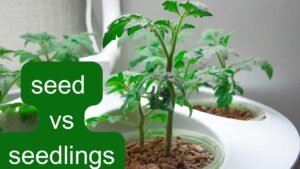
If you are growing tomatoes from seed, then you have a variety of options to cultivate, but it requires a lot more effort than seedlings.
For example, to grow from seed, you will have to start sowing seed around 6-8 weeks before the last expected frost date.
After that, you will want to harden them off and then transplant them into a garden or a container.
So, for a beginner gardener, buying tomato seedlings from a local nursery or a garden center is an easier option. By doing so, you can skip the seed-starting process, such as hardening them off or germinating them, etc.
Watering and feeding
For tomatoes to have healthy growth, water, and feeding are very important. Just like us, as humans, we need water and food to survive. Plants also need it.
Watering techniques and requirements
You have to continuously provide water to your tomato plant. At least 1 to 2 inch water per week. You can also use either rainfall or manual watering methods.
The best time to provide water to your plant is in the morning or evening. Don’t give it in the noon.
However, if you are growing in a container, you will want to water more frequently. And most of the time, you will provide daily because the soil dries out faster in the container.
Don’t provide too much or too little water. It can also cause some problems like winter leaves, yellow leaves, drop leaves, etc.
Fertilize your tomato plant
Fertilization is really important for a tomato plant. You can fertilize your plant with compost tea or fish emulsion.
- Compost tea will provide a nutrition-rich drink for your plant.
- Fish emulsion will supply all key nutrients like nitrogen, phosphorus, and potassium, which a tomato plant needs.
During the growing season, you will want to feed at least one time in 2 to 4 weeks with organic fertilizer so that your plant can continuously produce fruit and maintain its health.
However, you should always avoid over-fertilizing because it can do more harm than good. When you can read fertilizing instructions on the packaging, you can follow up with them.
Pruning and Staking
Pruning your tomato plant is another essential part of maintaining its healthy growth. So you can regularly remove the “suckers” that grow between the main stem and branches because they reduce the plant’s energy to produce bigger fruit.
If you are a beginner, then here is a simple pruning process.
- First of all, you have to identify the main stem of the plant and remove the sucker growing off it.
- You have to use a sharp pruner, or you can also snip off the sucker from your hand.
- However, make a cut just above the lowest leaf node.
- Make sure to prune regularly every one or two weeks.
Pest control and disease prevention
Here are some ways you can control pests and disease spreading on your tomato plant.
Common tomato plant problems
There are some common diseases that you will have to struggle with on your tomato plant, such as aphids, which suck the plant juice, and tomato hornworms, which can rapidly defoliate your plant.
Use Organic Remedies
To get rid of pests, you can use any organic method. For example, you can consider spraying your plant with neem oil or insecticidal soap. They can easily help your plant fight aphids and other soft-bodied insects.
Use beneficial insects
Another natural way to protect your tomato plant from pests is by attracting helpful predators like ladybugs and parasitic wasps to your garden.
They will naturally seek out and feed on common tomato pests. They are very beneficial insects and wonderful allies in maintaining a healthy, balanced ecosystem.
Common tomato plant disease
When growing a tomato plant at home, you can face some more prevalent tomato diseases, including early blight, late blight, and powdery mildew.
Because of Early blight, you will see brownish spots on your leaves and fruit, while if the problem is late blight, you can see that your plant is rapidly getting destroyed.
On the other hand, powdery mildew appears as white powder coating on leaves.
If you want to grow a disease-resistant plant, then I would suggest you go with varieties that are bred to have strong natural resistance.
You can also look for a label like “disease-resistant” or “Heirloom”.
Besides this, crop rotation is also important, so don’t plant tomatoes in the same spot year after year, as this can allow disease to build up in the soil. You can have a companion plant, as I have said before, too, like basil or marigolds.
Companion planting for healthier Tomatoes
If you are growing tomatoes at home and for your own purposes, like cooking, etc., Then I would suggest you grow some companion plants with tomatoes. It will increase your food production and home gardening experience.
Plants To grow with tomatoes:
- Basil: It’s a classic companion plant for tomatoes, and it has a strong aroma that can help keep pests like aphids and spider mites away; plus, basil and tomatoes complement each other wonderfully in the kitchen. That’s why you can have that in your tomato plant pot.
- Marigold: There are many people who like the smell of marigolds. However, many harmful nematodes and other pests from the soil don’t like its strong scent. So, that’s why you can consider having it.
- Garlic: You can also consider growing garlic with your tomato because it can help protect your plant from fungus disease and can also deter many common pests.
Plant to avoid growing with tomatoes:
Now you know that you can grow some plants with tomatoes, like basil, marigolds, garlic, etc. However, there are also plants that you will want to avoid planting too close to your tomatoes. Now let’s know about them:
- Potatoes: Tomatoes and potatoes are both susceptible to the same disease. So, it’s best if you keep them separate and not in the same garden or raised bed, container, etc. Because if you keep them together and if any of them get any disease, they both will be affected.
- Fennel: Fennel can stun your tomato’s growth. So it’s better if you keep them away from your tomatoes and plant them in a different pot.
- Walnut Trees: Walnut releases Juglone compound, which can be toxic to your tomato plants and inhibit their growth. That’s why you also want to keep them away from your tomatoes.
Seasonal tip for growing tomatoes
Well, you have to follow some different tips in spring, summer, fall, or winter. Let’s know about them one by one.
Spring planting
The ideal planting for tomatoes depends on the USDA hardiness zone in which you are located, and there are three main USDA hardiness zones.
- Zones 8-10: You can plant tomatoes outdoors in early spring, around 4-6 weeks before the last expected harvest date.
- Zones 5-7: You have to wait until after the last frost, which is usually mid-to-let spring, to plant tomatoes outside.
- Zones 3-4: You have to hold off on planting until the soil is thoroughly warmed up. So, often not until late spring or even early summer.
However, regardless of your zone, it is important to properly harden off any tomato seedling, no matter what variety you want to grow, before transplanting them outside. This means that you will gradually expose your tomato seedling to outdoor conditions. At least after one or two weeks, when they germinate.
Summer tomato plant care
During the summer season, your tomato plant will have to deal with heat stress and sunscald as they can be vulnerable to heat stress and sunscald during the hot summer months. However, you can protect them. If you follow the following tips:
- If you are growing in a pot or container, then during the summer season, in the afternoon, you can provide some shed to your port. Either you can position it from the place where you usually keep out. Or you can shed it with a cloth.
- Mulching is another useful method that you can apply. You can mulch well around the base of your plant. It will keep your plant’s soil cool and moisturized. Besides this, it can also suppress unwanted plant growth, which we also call weeding.
- During the summer season, you also want to monitor your tomato plant and look for any signs of wilting or scratching on the leaves and fruit.
Water more frequently in hot months
Tomato plants need consistent moisturizer, especially during peak summer or heat waves. So you need to provide water more frequently, potentially daily or even twice a day in extreme heat.
You have to provide water in the morning and evening and avoid it in the afternoon.
Besides this, you can also check the soil continuously. If you are providing one time, and if you see the soil is completely dry out, then provide water. However, don’t provide too much, that is not good either.
Here are some tips you can look for before providing water:
- Check the soil daily to see whether it’s completely dry or not.
- Water when the top one or two inches feel dry.
- Water deeply.
- Apply one or more inches of water each time. It’ll encourage deep growth.
- Avoid getting water on the leaves because it can promote fungus disease.
Growing Tomatoes During Fall or Winter
If you are living in warmer climates or you have access to a greenhouse, then you can extend your tomato growing season even in fall or winter.
During the fall or winter season, you can use row covers, cold frames, or greenhouses to protect your plants from frost. By doing so, you can get a head start on the season. Or keep your plant producing longer. You just have to maintain the right temperature, humidity, light level indoors or under cover.
Harvesting and storing tomatoes
Now, after doing so much hard work, from growing tomatoes and seeds to providing them care, etc., Now it’s time to, you know, about harvesting and storing.
Signs of ripeness and when to pick?
The best time to harvest tomatoes is when they are fully ripe and have their rich, vibrant color. But color also depends on the variety.
Sometimes, it can be a red color, and sometimes, it can be bright yellow or even a purple-black hue.
However, you can still gently squeeze the tomato. It can also give you a sign of whether it’s ready to harvest or not. Also, I noticed one thing: ripe tomatoes will easily detach from the veins when you lift them.
Step-by-step harvesting
When you are picking your tomato, be gentle and avoid damaging the fruit. You have to use clean hands or pruning shears to carefully clip the skin.
Besides this, you want to leave a small portion attached to the tomato. Plus, you should avoid pulling or twisting the tomatoes as they can even tear their skin, which will not be good for storing tomatoes.
It is best to harvest tomatoes in the morning when the plants are cool.
Store tomatoes for the best flavor
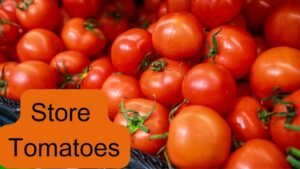
The refrigerator is not ideal for storing ripe tomatoes because the cold temperature can actually break down the tomato cell structure and mute its natural sweetness and complex flavors.
Instead, I suggest you keep tomatoes at room temperature, ideally in a single layer, out of direct sunlight. By doing so, you can continue refining and developing their full, delicious flavor.
How long can you keep a tomato?
If you properly store tomatoes at room temperature, then fresh tomatoes can typically last around 3-7 days before needing to be used or preserved.
Besides this, the tomato timeline also depends on its variety, how ripe they were when you picked it, and the ambient temperature.
Many people keep tomatoes in the refrigerator for more than 7-10 days, but keeping them out of the fridge is the key to retaining that amazing homegrown taste.
Best tomato Preserving Method
If you want to preserve your homegrown tomatoes for the long term, then there are a few great preservation options that anyone can follow:
- Canning: Tomatoes can be canned whole, diced, or as sauces/purees. It’s a nice way to enjoy your homegrown tomatoes all year round.
- Drying: Dehydrating tomatoes to sun-dried or even oven-dried is another good option. By doing so, tomatoes concentrate their flavor, and it allows for extended shelf life.
- Freezing: That’s one of the most common methods that most people know about. You can also freeze your tomatoes sliced or in sauce.
Bonus tips for growing the best organic tomatoes
Now that we know how to grow tomatoes at home in the garden, balcony, backyard, or any other place in any season, it’s time to learn some bonus tips regarding growing organic tomatoes.
Use organic mulch to retain moisture and prevent weeds
You can apply 2-3 inch layers of organic mulch like wood chips, leaves, and straw around the base of your tomato plant. It is really beneficial.
It can help your plant to retain soil moisture. Prevent unwanted plants by suppressing weeds. It can also prevent the plant from drying by saving it from extreme heat or cold.
Create homemade compost and natural fertilizer for top results
You can also feed your tomato plant with nutrient-rich homemade compost or natural fertilizer. It takes your yield to the next level.
The compost will provide a slow, steady release of essential nutrients that your plant needs. You can use organic fertilizer like bone meal, blood meal, or kelp to give your plant an extra boost.
Use companion Plants
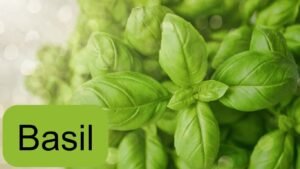
Throughout this article, I have discussed multiple times that you have to use companion plants like Basil, Marigolds, or nasturtiums, etc. They will help your plant to fight aphids, hornworms, etc.
Conclusion
Growing tomatoes at home is very easy. You can use containers or pots on your balcony or backyard. After that, you have to fill it with a high-quality potting mix and then choose a variety, whichever you like. For example, cherry tomatoes, which I also have. And then you can grow them from seed.
However, if you are a beginner, you can also get seedlings from a local nursery to save your time because it’s not time-consuming. And after that, you just have to provide around 6 hours of direct sunlight and water every day in the morning or evening. And sometimes even twice, especially during hot days. If everything goes well, then within 90 days, you will have tomatoes to harvest.
FAQ: Growing Tomatoes
Here are some frequently asked questions that people ask when they try to grow tomatoes at home or sometimes even in pot, ground, etc.
How long does it take tomatoes to grow from seed?
It takes around 5 to 10 days for tomatoes to germinate. On the other hand, from seed to harvest, most tomato varieties take around 60 to 85 days, including both the seedling stage and the growth after transplanting.
How much sunlight do tomatoes need?
Tomatoes need around 6 to 8 hours of direct sunlight every day to thrive perfectly. The more sunlight your tomato plant gets, the better its growth and fruit production will be.
What type of soil is best for growing tomatoes?
Well, tomatoes grow best in well-drained, fertile soil that has a pH of around 6.0 to 6.8. You can also add organic matter like compost to improve your soil quality and promote healthy plant growth.
How often should I water my tomato plant?
Well, tomato plants need consistent water. But now it depends on the conditions, like whether it is winter, spring, summer, etc. On average, they need at least 2-3 times a week.
I live at 25°C on average, and I provide it with water every day. On the other hand, if you are living in a temperature which is too extreme or high, like 34°C or 40°C, sometimes you can even provide twice a day, in the morning and in the evening.
But when watering your tomato plant, you want to make sure that the soil is completely dry because over-watering is not good for tomato plants.
How do I know if my tomatoes are ready to harvest?
Well, you can easily identify if your tomatoes are ready to harvest. The first is their color. You will feel they are slightly soft when you squeeze them.
Most of the time, their color is red; sometimes, it’s a little yellowish, too, depending on the variety. Besides this, your tomatoes should also look glossy and smooth for the best flavor.
Are tomatoes better in pots or in the ground?
Tomatoes are better in both places, in pots and in the ground. However, they just want proper space to spread their roots, proper sunlight, water, fertilizer, etc. So you just have to provide proper care. It doesn’t matter whether it’s a pot or ground. Just provide good, high-quality soil and care.
Even for a second, we assume that tomatoes are better in the pots. But what if you are not providing proper water, fertilizer, etc.? So, do you think it will grow? Of course not. Because tomato plants just want proper space, soil, and care. That’s it. If you can provide your plant with all these things, then you can grow tomatoes in pots, containers, in-ground, raised beds, etc. It doesn’t matter.
